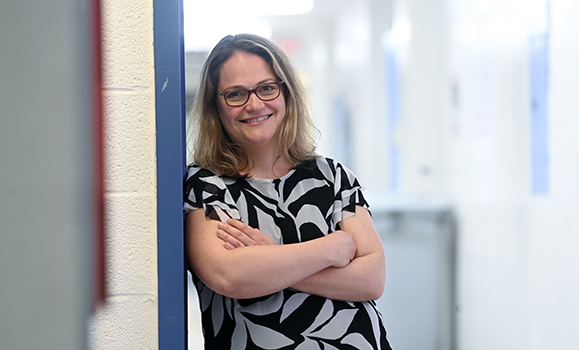Canadians will learn more about their lung health and how to improve it thanks to a $3.5-million grant from the Canadian Institutes of Health Research for Dalhousie’s Dr. Sanja Stanojevic and a national team of researchers.Ěý
“It’s a really exciting time to move lung health research forward in Canada,” says Dr. Stanejovic, an associate professor at the ’s .
The five-year grant, called Harnessing Data to Improve Lung Health in Canada, will allow Dr. Stanojevic and her colleagues at universities in five other provinces to establish a national patient registry, link an international network of researchers to lung health data, and train the next generation of respiratory health researchers.Ěý
As part of the grant, the researchers will also work with the and other partners to create an accessible screening tool called CAN-LUNG score, to help people assess their own lung health.
As many as 20 per cent of people in Canada suffer from some form of , including Chronic Obstructive Pulmonary Disease (COPD), asthma, and rarer illnesses, such as pulmonary fibrosis, interstitial lung disease and cystic fibrosis.Ěý
Nova Scotians have among the highest rates of lung disease in the country, particularly for COPD and lung cancer, especially amongst non-smokers.Ěý
A path to more personalized treatment
Even though these rates of lung disease are high, they are probably an underestimate. That’s because most people are unaware of their overall lung health, Dr. Stanojevic says, “even though many of the factors that ultimately lead to mortality are linked to how our lungs function.”
Breathing tests are difficult to obtain and not readily available through primary health-care providers, she adds.
“Because we have this limited access, many people go through their entire lives not having their lung health tested,” she says. “But if we monitor lung health, we have a better chance of seeing the early warning signs of other chronic conditions that may be developing.”Ěý

By making it easier for everyone to gauge their lung function through a CAN-LUNG score and connecting researchers with existing data and a new patient registry to help scientists pursue research, Dr. Stanojevic believes this initiative will improve our understanding of lung disease.
Researchers with access to these expanded data networks will also be able to study differences in the way women and men experience lung disease, and, eventually, to develop more personalized treatments, she hopes.Ěý
Streamlining data access
Through an interactive website called Data4LungHealth, Dr. Stanojevic and her colleagues will streamline researchers’ access to Canadian lung health data and enable scientists to easily upload new data and community resources. The website and an associated data infrastructure called shAIRe (Scientific and Health Data Assets in Respiratory Research) will make it easier for future national and international research collaboration, Dr. Stanojevic says.Ěý
At an individual level, it’s important for people to be aware of their lung function, she adds.Ěý
“Knowing and monitoring your lung health, just like you monitor your blood pressure or cholesterol, can help inform behaviours,” she says.Ěý
Lung health is determined by a combination of factors that begin in utero and in childhood, such as environmental exposures, early infections, psychological stress, and nutrition to support lung growth and development, Dr. Stanojevic says.
“All of those things influence how lungs grow, and are also related to cardiovascular disease, cancer and many other outcomes,” she adds.
Behavioural changes
There are also components of lung health that people can improve through behavioural choices.Ěý
For example, if people know their lung health is compromised, they might choose not to smoke, or not to go outside when air quality is bad, such as from forest fires, or to purchase indoor air filters, she says.Ěý
Ultimately, Dr. Stanojevic would like to see doctors test people’s lung functions regularly, beginning in childhood and then periodically, throughout adulthood. Respirologists could upload people’s pulmonary function tests to their electronic patient record, as a marker or early warning sign of potential problems.Ěý
Researchers at McGill, UBC, the Ottawa Hospital Research Institute, the University of Alberta, and the University of Toronto are also participating in the project.Ěý

